Yueqin Yin
KodCode: A Diverse, Challenging, and Verifiable Synthetic Dataset for Coding
Mar 04, 2025Abstract:We introduce KodCode, a synthetic dataset that addresses the persistent challenge of acquiring high-quality, verifiable training data across diverse difficulties and domains for training Large Language Models for coding. Existing code-focused resources typically fail to ensure either the breadth of coverage (e.g., spanning simple coding tasks to advanced algorithmic problems) or verifiable correctness (e.g., unit tests). In contrast, KodCode comprises question-solution-test triplets that are systematically validated via a self-verification procedure. Our pipeline begins by synthesizing a broad range of coding questions, then generates solutions and test cases with additional attempts allocated to challenging problems. Finally, post-training data synthesis is done by rewriting questions into diverse formats and generating responses under a test-based reject sampling procedure from a reasoning model (DeepSeek R1). This pipeline yields a large-scale, robust and diverse coding dataset. KodCode is suitable for supervised fine-tuning and the paired unit tests also provide great potential for RL tuning. Fine-tuning experiments on coding benchmarks (HumanEval(+), MBPP(+), BigCodeBench, and LiveCodeBench) demonstrate that KodCode-tuned models achieve state-of-the-art performance, surpassing models like Qwen2.5-Coder-32B-Instruct and DeepSeek-R1-Distill-Llama-70B.
Segmenting Text and Learning Their Rewards for Improved RLHF in Language Model
Jan 06, 2025Abstract:Reinforcement learning from human feedback (RLHF) has been widely adopted to align language models (LMs) with human preference. Prior RLHF works typically take a bandit formulation, which, though intuitive, ignores the sequential nature of LM generation and can suffer from the sparse reward issue. While recent works propose dense token-level RLHF, treating each token as an action may be oversubtle to proper reward assignment. In this paper, we seek to get the best of both by training and utilizing a segment-level reward model, which assigns a reward to each semantically complete text segment that spans over a short sequence of tokens. For reward learning, our method allows dynamic text segmentation and compatibility with standard sequence-preference datasets. For effective RL-based LM training against segment reward, we generalize the classical scalar bandit reward normalizers into location-aware normalizer functions and interpolate the segment reward for further densification. With these designs, our method performs competitively on three popular RLHF benchmarks for LM policy: AlpacaEval 2.0, Arena-Hard, and MT-Bench. Ablation studies are conducted to further demonstrate our method.
Diffusion-RPO: Aligning Diffusion Models through Relative Preference Optimization
Jun 10, 2024Abstract:Aligning large language models with human preferences has emerged as a critical focus in language modeling research. Yet, integrating preference learning into Text-to-Image (T2I) generative models is still relatively uncharted territory. The Diffusion-DPO technique made initial strides by employing pairwise preference learning in diffusion models tailored for specific text prompts. We introduce Diffusion-RPO, a new method designed to align diffusion-based T2I models with human preferences more effectively. This approach leverages both prompt-image pairs with identical prompts and those with semantically related content across various modalities. Furthermore, we have developed a new evaluation metric, style alignment, aimed at overcoming the challenges of high costs, low reproducibility, and limited interpretability prevalent in current evaluations of human preference alignment. Our findings demonstrate that Diffusion-RPO outperforms established methods such as Supervised Fine-Tuning and Diffusion-DPO in tuning Stable Diffusion versions 1.5 and XL-1.0, achieving superior results in both automated evaluations of human preferences and style alignment. Our code is available at https://github.com/yigu1008/Diffusion-RPO
Self-Augmented Preference Optimization: Off-Policy Paradigms for Language Model Alignment
May 31, 2024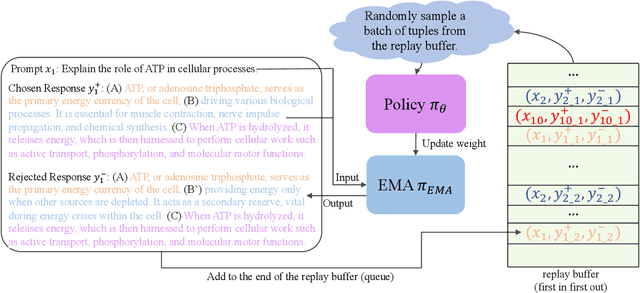

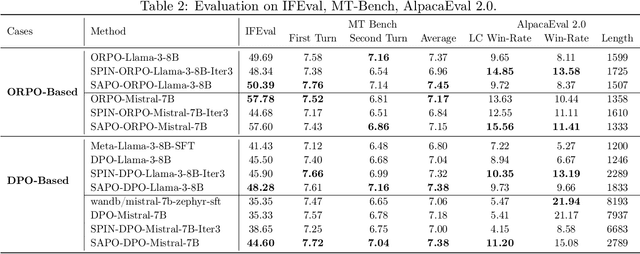

Abstract:Traditional language model alignment methods, such as Direct Preference Optimization (DPO), are limited by their dependence on static, pre-collected paired preference data, which hampers their adaptability and practical applicability. To overcome this limitation, we introduce Self-Augmented Preference Optimization (SAPO), an effective and scalable training paradigm that does not require existing paired data. Building on the self-play concept, which autonomously generates negative responses, we further incorporate an off-policy learning pipeline to enhance data exploration and exploitation. Specifically, we employ an Exponential Moving Average (EMA) model in conjunction with a replay buffer to enable dynamic updates of response segments, effectively integrating real-time feedback with insights from historical data. Our comprehensive evaluations of the LLaMA3-8B and Mistral-7B models across benchmarks, including the Open LLM Leaderboard, IFEval, AlpacaEval 2.0, and MT-Bench, demonstrate that SAPO matches or surpasses established offline contrastive baselines, such as DPO and Odds Ratio Preference Optimization, and outperforms offline self-play methods like SPIN. Our code is available at https://github.com/yinyueqin/SAPO
Relative Preference Optimization: Enhancing LLM Alignment through Contrasting Responses across Identical and Diverse Prompts
Feb 12, 2024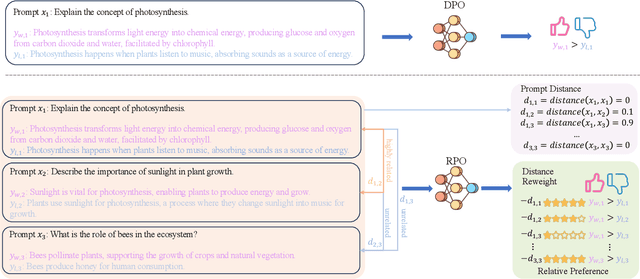

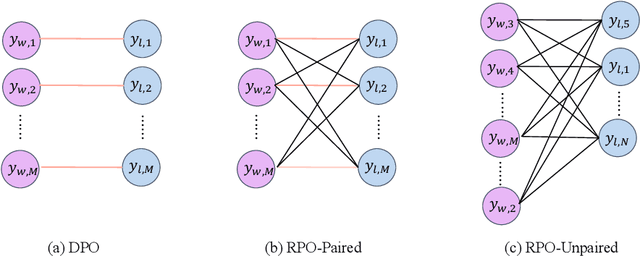

Abstract:In the field of large language models (LLMs), aligning models with the diverse preferences of users is a critical challenge. Direct Preference Optimization (DPO) has played a key role in this area. It works by using pairs of preferences derived from the same prompts, and it functions without needing an additional reward model. However, DPO does not fully reflect the complex nature of human learning, which often involves understanding contrasting responses to not only identical but also similar questions. To overcome this shortfall, we propose Relative Preference Optimization (RPO). RPO is designed to discern between more and less preferred responses derived from both identical and related prompts. It introduces a contrastive weighting mechanism, enabling the tuning of LLMs using a broader range of preference data, including both paired and unpaired sets. This approach expands the learning capabilities of the model, allowing it to leverage insights from a more varied set of prompts. Through empirical tests, including dialogue and summarization tasks, and evaluations using the AlpacaEval2.0 leaderboard, RPO has demonstrated a superior ability to align LLMs with user preferences and to improve their adaptability during the training process. The PyTorch code necessary to reproduce the results presented in the paper will be made available on GitHub for public access.
Efficient-VQGAN: Towards High-Resolution Image Generation with Efficient Vision Transformers
Oct 09, 2023Abstract:Vector-quantized image modeling has shown great potential in synthesizing high-quality images. However, generating high-resolution images remains a challenging task due to the quadratic computational overhead of the self-attention process. In this study, we seek to explore a more efficient two-stage framework for high-resolution image generation with improvements in the following three aspects. (1) Based on the observation that the first quantization stage has solid local property, we employ a local attention-based quantization model instead of the global attention mechanism used in previous methods, leading to better efficiency and reconstruction quality. (2) We emphasize the importance of multi-grained feature interaction during image generation and introduce an efficient attention mechanism that combines global attention (long-range semantic consistency within the whole image) and local attention (fined-grained details). This approach results in faster generation speed, higher generation fidelity, and improved resolution. (3) We propose a new generation pipeline incorporating autoencoding training and autoregressive generation strategy, demonstrating a better paradigm for image synthesis. Extensive experiments demonstrate the superiority of our approach in high-quality and high-resolution image reconstruction and generation.
DiffGAR: Model-Agnostic Restoration from Generative Artifacts Using Image-to-Image Diffusion Models
Oct 16, 2022



Abstract:Recent generative models show impressive results in photo-realistic image generation. However, artifacts often inevitably appear in the generated results, leading to downgraded user experience and reduced performance in downstream tasks. This work aims to develop a plugin post-processing module for diverse generative models, which can faithfully restore images from diverse generative artifacts. This is challenging because: (1) Unlike traditional degradation patterns, generative artifacts are non-linear and the transformation function is highly complex. (2) There are no readily available artifact-image pairs. (3) Different from model-specific anti-artifact methods, a model-agnostic framework views the generator as a black-box machine and has no access to the architecture details. In this work, we first design a group of mechanisms to simulate generative artifacts of popular generators (i.e., GANs, autoregressive models, and diffusion models), given real images. Second, we implement the model-agnostic anti-artifact framework as an image-to-image diffusion model, due to its advantage in generation quality and capacity. Finally, we design a conditioning scheme for the diffusion model to enable both blind and non-blind image restoration. A guidance parameter is also introduced to allow for a trade-off between restoration accuracy and image quality. Extensive experiments show that our method significantly outperforms previous approaches on the proposed datasets and real-world artifact images.
TransEditor: Transformer-Based Dual-Space GAN for Highly Controllable Facial Editing
Mar 31, 2022
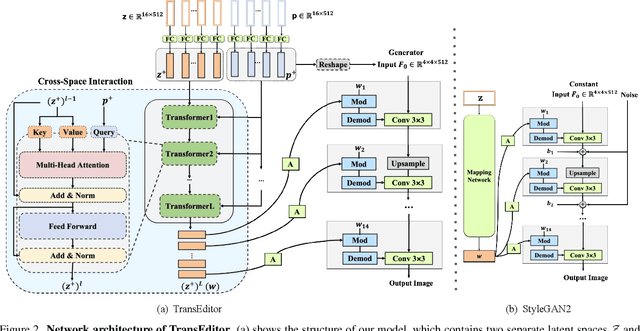

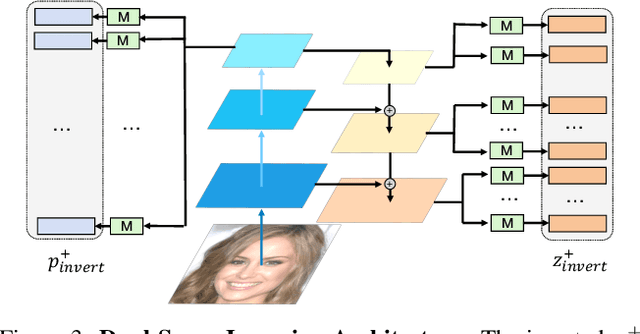
Abstract:Recent advances like StyleGAN have promoted the growth of controllable facial editing. To address its core challenge of attribute decoupling in a single latent space, attempts have been made to adopt dual-space GAN for better disentanglement of style and content representations. Nonetheless, these methods are still incompetent to obtain plausible editing results with high controllability, especially for complicated attributes. In this study, we highlight the importance of interaction in a dual-space GAN for more controllable editing. We propose TransEditor, a novel Transformer-based framework to enhance such interaction. Besides, we develop a new dual-space editing and inversion strategy to provide additional editing flexibility. Extensive experiments demonstrate the superiority of the proposed framework in image quality and editing capability, suggesting the effectiveness of TransEditor for highly controllable facial editing.
 Add to Chrome
Add to Chrome Add to Firefox
Add to Firefox Add to Edge
Add to Edge